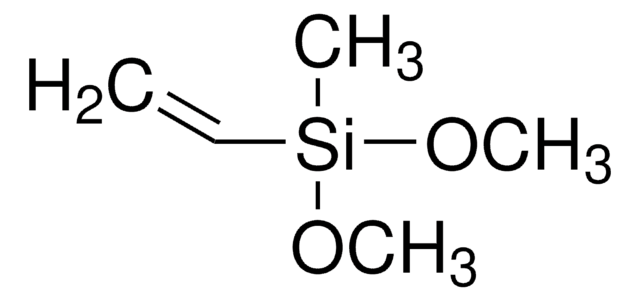539252
3-Glycidoxypropyldimethoxymethylsilane
97%
Sinônimo(s):
(3-Glycidoxypropyl)methyldimethoxysilane
Faça loginpara ver os preços organizacionais e de contrato
About This Item
Fórmula empírica (Notação de Hill):
C9H20O4Si
Número CAS:
Peso molecular:
220.34
Número CE:
Número MDL:
Código UNSPSC:
12352103
ID de substância PubChem:
NACRES:
NA.23
Produtos recomendados
Nível de qualidade
Ensaio
97%
forma
liquid
índice de refração
n20/D 1.432 (lit.)
pb
100 °C/4 mmHg (lit.)
densidade
1.02 g/mL at 25 °C (lit.)
cadeia de caracteres SMILES
CO[Si](C)(CCCOCC1CO1)OC
InChI
1S/C9H20O4Si/c1-10-14(3,11-2)6-4-5-12-7-9-8-13-9/h9H,4-8H2,1-3H3
chave InChI
WHGNXNCOTZPEEK-UHFFFAOYSA-N
Descrição geral
3-Glycidoxypropyldimethoxymethylsilane (GDMMS) is an epoxy-silane that is used to form a silane based coupling agent for functionalization of a variety of substrates. The epoxy groups allow good adhesion of surface atoms and form a stable polymeric structure.
Aplicação
3-Glycidoxypropyldimethoxymethylsilane (GDMMS) precursor was used to develop zwitterionic push – pull chromophore and carbazole-derivatives-doped hybrid organic–inorganic homogeneous films.{71}
GDMMS can surface modify indium tin oxide (ITO) glass substrate for the immobilization of surface atoms which can be further used for the electrochemical detection and labeling. It can also be used as a hardener in the formation of multi-component silicone based rubber.
The usual cure time is 16-20 hours at room temperature or 1 hour at 100C.
Código de classe de armazenamento
10 - Combustible liquids
Classe de risco de água (WGK)
WGK 3
Ponto de fulgor (°F)
221.0 °F - closed cup
Ponto de fulgor (°C)
105 °C - closed cup
Equipamento de proteção individual
Eyeshields, Gloves, multi-purpose combination respirator cartridge (US)
Escolha uma das versões mais recentes:
Já possui este produto?
Encontre a documentação dos produtos que você adquiriu recentemente na biblioteca de documentos.
Os clientes também visualizaram
Headgroup effect on silane structures at buried polymer/silane and polymer/polymer interfaces and their relations to adhesion.
Zhang C, et al.
Langmuir, 28(14), 6052-6059 (2012)
Surface functionalization using catalyst-free azide- alkyne cycloaddition.
Kuzmin A, et al.
Bioconjugate Chemistry, 21(11), 2076-2085 (2010)
Label-free ITO-based immunosensor for the detection of very low concentrations of pathogenic bacteria.
dos Santos MB, et al.
Bioelectrochemistry, 101(11), 146-152 (2015)
Francesca Volpetti et al.
ACS synthetic biology, 6(11), 1979-1987 (2017-08-05)
Synthetically engineered cells are powerful and potentially useful biosensors, but it remains problematic to deploy such systems due to practical difficulties and biosafety concerns. To overcome these hurdles, we developed a microfluidic device that serves as an interface between an
Electro-optics poled sol?gel materials doped with heterocycle push?pull chromophores.
Della Giustina G, et al.
Materials Science & Engineering. C, Materials For Biological Applications, 26(5), 979-982 (2006)
Nossa equipe de cientistas tem experiência em todas as áreas de pesquisa, incluindo Life Sciences, ciência de materiais, síntese química, cromatografia, química analítica e muitas outras.
Entre em contato com a assistência técnica












